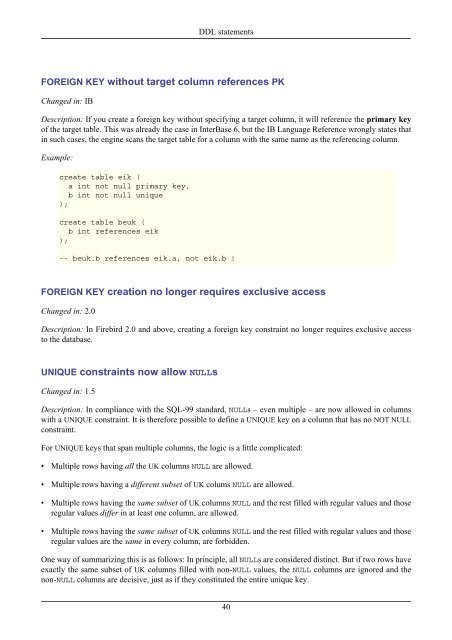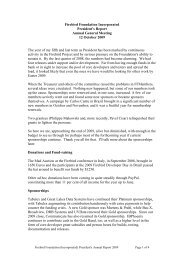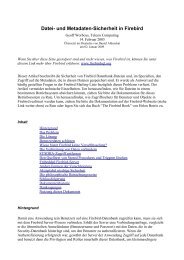Firebird 2.1 Language Reference Update
Firebird 2.1 Language Reference Update
Firebird 2.1 Language Reference Update
Create successful ePaper yourself
Turn your PDF publications into a flip-book with our unique Google optimized e-Paper software.
DDL statements<br />
FOREIGN KEY without target column references PK<br />
Changed in: IB<br />
Description: If you create a foreign key without specifying a target column, it will reference the primary key<br />
of the target table. This was already the case in InterBase 6, but the IB <strong>Language</strong> <strong>Reference</strong> wrongly states that<br />
in such cases, the engine scans the target table for a column with the same name as the referencing column.<br />
Example:<br />
create table eik (<br />
a int not null primary key,<br />
b int not null unique<br />
);<br />
create table beuk (<br />
b int references eik<br />
);<br />
-- beuk.b references eik.a, not eik.b !<br />
FOREIGN KEY creation no longer requires exclusive access<br />
Changed in: 2.0<br />
Description: In <strong>Firebird</strong> 2.0 and above, creating a foreign key constraint no longer requires exclusive access<br />
to the database.<br />
UNIQUE constraints now allow NULLs<br />
Changed in: 1.5<br />
Description: In compliance with the SQL-99 standard, NULLs – even multiple – are now allowed in columns<br />
with a UNIQUE constraint. It is therefore possible to define a UNIQUE key on a column that has no NOT NULL<br />
constraint.<br />
For UNIQUE keys that span multiple columns, the logic is a little complicated:<br />
• Multiple rows having all the UK columns NULL are allowed.<br />
• Multiple rows having a different subset of UK colums NULL are allowed.<br />
• Multiple rows having the same subset of UK columns NULL and the rest filled with regular values and those<br />
regular values differ in at least one column, are allowed.<br />
• Multiple rows having the same subset of UK columns NULL and the rest filled with regular values and those<br />
regular values are the same in every column, are forbidden.<br />
One way of summarizing this is as follows: In principle, all NULLs are considered distinct. But if two rows have<br />
exactly the same subset of UK columns filled with non-NULL values, the NULL columns are ignored and the<br />
non-NULL columns are decisive, just as if they constituted the entire unique key.<br />
40

















